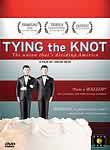Tying The Knot

Starring: Lois Marrero
87 minutes (released 2004) rated NR
Directed by Jim de Seve
First time director Jim de Seve’s thought-provoking documentary, “Tying the Knot”, looks at the institution of marriage in America and what part same-sex couples are allowed to play in it. Focusing on the stories of two individuals, each of whom is dealing with the loss of their same-sex partner, the film shows the obstacles they encounter when dealing with laws in a society which forbids same sex marriage. Following them as they struggle to obtain even the most rudimentary benefits afforded legally married couples, it becomes clear that there is a huge gap in America’s legal system which does not recognize same sex couples.
The film features interviews with people on both sides of this hotly debated issue, including political and religious leaders such as Sen. John Kerry and Dr. James Dobson. In an interview with “What is Marriage For” author E.J. Graff describes the short history of marriage. She notes that, up until the 1920’s industrialized period, marriage was typically a business arrangement driven primarily by people’s need to be linked up with partners which were compatible with their economic situation; people married for business first and love second. However, once the Industrial Age kicked into gear, people started working for companies and moved away from complete reliance on their own business for income. This freed them up to marry someone who didn’t necessarily know anything about their business – in effect, they could marry for love first, business second. The current standard for marriage, marrying for love, is accepted by church and state alike. Ms. Graff points out: “Is marriage made by love? If so, then same sex couples belong”.
The film also traces the political history of same sex marriage, both in the U.S. and abroad. It notes both the triumphs of same-sex marriage advocates – Hawaii’s 1993 Supreme Court ruling which deemed same-sex marriages legal and Holland’s 2001 law which defines marriage as being between “any two consenting adults” – and the disappointments – President Clinton’s 1996 signing the Defense of Marriage Act into law (which allowed states not be required to recognize marriages from other states) and Hawaii’s subsequent 1998 amendment of their constitution to limit marriage to different sexes. Extensive footage, some dating to the 1970s, of political rallies, marches and attempts by same-sex couples to get married at county courthouses underlines the effort with which U.S citizens have been attempting to get the government to recognize what is already a committed union. Connie Ress from Marriage Equality states it best: “The reality is that our families do exist and we need the government to recognize that. We need the laws to catch up with that reality”.
Using the case of Richard and Mildred Love, who in 1967 were arrested for being an inter-racial married couple, de Seve draws a strong parallel between the struggle for inter-racial marriage and same-sex couples’ rights to marry. The film points out that many of the same arguments currently used against same-sex unions were argued previously to deny inter-racial couples the right to marry. What now is considered commonplace was once decried as causing “society to fall apart” and “bad for children”. Perhaps Rep. Maxine Waters, shown on the House floor, sums up the message of this movie best: “We have a responsibility to represent ALL Americans as members of the House of Representatives. Let us not be guided by prejudice, ignorance and fear”.
Information published on The Rainbow Babies website is not a substitute for proper medical advice, diagnosis, treatment or care. Always seek the advice of a physician or other qualified health providers with any questions you may have regarding a medical condition.
Disclaimer: The Rainbow Babies provides sample contracts and legal/social health articles for informational purposes only—please do not consider it as legally-binding advice of any kind.


